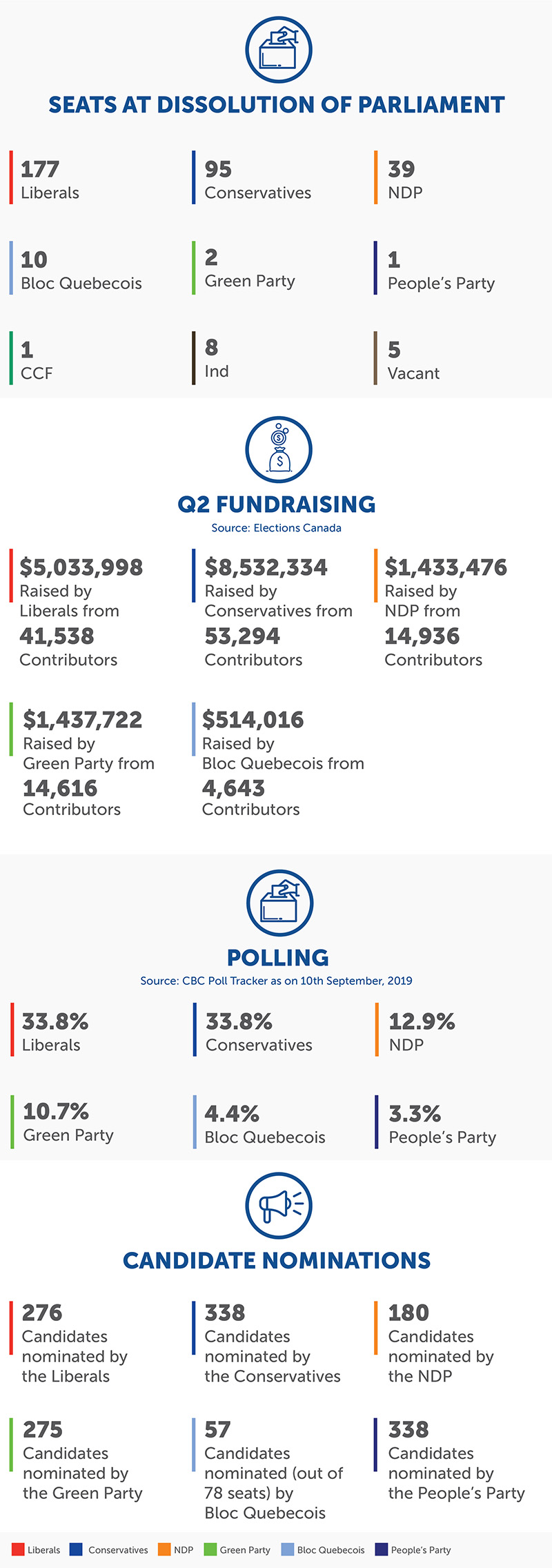Election State of Play: 2019 Federal Election Updates

During the 43rd federal election, StrategyCorp will provide a weekly analysis of the campaign, while our new Institute of Public Policy and Economy publishes in-depth policy and issues analyses. Together, these will not only keep you up to date on a fast-paced election campaign, but also give you a deeper understanding of Canada’s political and policy scene after the October 21st vote.
Election 43 – State of Play:
Prime Minister Justin Trudeau and the Liberals must convince voters to keep the faith.
Andrew Scheer and the Conservative Party will attempt to show that the Liberals ignore issues that matter to everyday families.
Jagmeet Singh and the New Democrats are fighting for political survival and must convince Canadians that a left-leaning alternative to the Liberals is worth their vote.
Elizabeth May and the Green Party of Canada will try to convert a stronger base of support in the early days of this election into a breakthrough in seats.
Maxime Bernier and the People’s Party of Canada look to win seats or at least spoil Conservative hopes and force the CPC further to the right.
Yves-François Blanchet and the Bloc Québécois look to regain party status after winning only 10-seats in 2015.

Liberals
Typically, parties win office on hope for change, and keep office on fear of change. But the Liberal victory in 2015 rested on a fragile coalition of young first-time voters, potential NDP swing voters, and sometime Liberals united by a positive, upbeat, and authentic campaign. Now with a four-year track record, the Liberals face a new challenge: a tarnished brand among some of the core constituencies of their 2015 coalition. For many millennial and progressive voters, the party and its Leader have lost some of the sincerity that motivated them to turn out to the polls last time. In their minds, “Sunny Ways” has been replaced with the operating style of conventional politics.
Therefore, the Liberal strategy requires nuance: they need to be negative enough to ensure progressive voters are worried about Andrew Scheer’s Conservatives and rally to Justin Trudeau, but positive enough to give 2015-coalition and first-time voters a reason to return to the polls. Hence the message of “Choose Forward.”
The Liberals have chosen policy planks that underline this strategy. They are offering a middle-class agenda on pharmacare, an environmental program, and more government spending to help make life more affordable. The Liberals will contrast their agenda with a narrative of the Conservatives providing tax cuts for the rich, having no environmental policy, and raising doubt on social issues.
The Liberals hope their positive progressive policy platform will consolidate the centre-left vote around their party, despite the challenges with Trudeau’s image after the SNC-Lavalin fallout. In Quebec, the Liberals are planning on large gains with the collapse of the NDP. They will need to gain this vote while keeping Bloc voters at bay and ensuring that the Conservatives are confined to pockets of support.
The Liberals have other reasons for optimism including:
- Running incumbents in almost all the seats they need to win, having lost just 10% of their 177 incumbents to retirement, compared to 15% of the CPC and a whopping 34% of the NDP caucus.
- The SNC issue appears “baked in” to voting intention, barring a mid-campaign RCMP investigation.
- No first term majority government failed to win re-election to a second term since R.B. Bennet in the throes of the Great Depression.

Conservatives
For the first time in its almost twenty-year history, the Conservative Party will enter an election led by someone other than Stephen Harper. Andrew Scheer now has the challenge of trying to balance fiscal and social conservative wings in English Canada while growing his caucus in Quebec. He needs to ensure that the coalition Harper built remains strong and ready to turnout as they have in every election since 2006.
But that will not be enough to win. Scheer also needs the fragile coalition who voted for Trudeau in 2015 to either switch their vote to a left-wing alternative or stay at home. Hence a second message aimed at wavering Liberals of “Justin Trudeau: Not as Advertised.” If voter turnout rises above 65%, the same level as election 2015, it will mean the Conservatives have no chance of forming government. Many of the levers for the Conservatives to gain power are not within their control, but in the hands of disaffected Liberal voters, the NDP, and Greens.
The Conservatives also have reasons for optimism:
- Barring a significant shift in the election dynamic, the Tories should almost run the table on the Prairies, gain seats in Atlantic Canada, and increase seats in Quebec.
- The battlefields in Ontario and BC are made up of seats the CPC won in 2011, lost in 2015, and need “only” win back in 2019.
- Organizationally, they lead on candidate nominations, with a full slate nominated last week, compared to 80% for the Liberals and just over 50% for the NDP.
- Conservatives lead in fundraising and have already raised more than $16.5 million in the first six months of 2019.

New Democrats
Historic low voter support, dismal fundraising, mass defections, a fraying coalition, and a leader making few inroads with Canadians make Jagmeet Singh’s NDP a shadow of Jack Layton’s alliance of cosmopolitan progressives and modest small-city workers in English and French Canada. They risk losing “stop the Conservative” strategic votes to the Liberals, environmentalists to the Greens, soft nationalists to the Bloc, and hard-hat workers in small towns to the Conservatives.
The NDP are not defenseless and can respond to these forces. A union-backed ground game will help get out the vote with a concerted effort focused on promising areas like Brampton and Burnaby. One reason for optimism is that, unlike the Greens, the NDP and its staff have campaign experience under the national spotlight.

Greens
It is conceivable that the Green Party has a path to Official Party Status during this campaign. Their leader, Elizabeth May, has campaigned as party leader for the last several elections so she has more experience than all her counterparts. If the Greens continue to pick up momentum, expect Liberal and NDP opposition researchers to dig into the Green Party’s 338 candidates for every controversial statement or embarrassing tweet they can find.
However, according to the latest research from Innovative Research Group, the Green’s recent surge has moved them from 17% to 20% in their 15 strongest ridings – a gain that will not result in more seats in the House of Commons.

Bloc Quebecois
Despite years of spectacular self-inflicted wounds under former leader Martine Ouellet, ranging from public recriminations to the resignation of much of her caucus, the Bloc has still survived to fight yet another election. Ouellet’s replacement with the feisty former Parti Québécois minister Yves-François Blanchet make the Bloc a potential “wild card” in this campaign. Even though Blanchet is relatively new to the federal scene, he’s not new to politics. A collapsing NDP combined with underperforming Greens and Liberals in Quebec could leave the geographically concentrated Bloc holding the balance of power in Ottawa.

People’s Party
Formed weeks after Conservative cabinet minister and leadership runner-up Maxime Bernier quit the Conservative Party, the People’s Party of Canada (PPC) is promoting opposition to immigration, climate skepticism, and anti-elite sentiment in line with populist movements in Europe. While Bernier may lose his seat and win no others, if it’s a razor-thin contest even the sixth party could matter. Given 51 seats were decided by less than 5% of the vote in 2015 and the PPC is running candidates in all of Canada’s 338 ridings, they could play spoiler in enough local races to change the outcome of this election.

